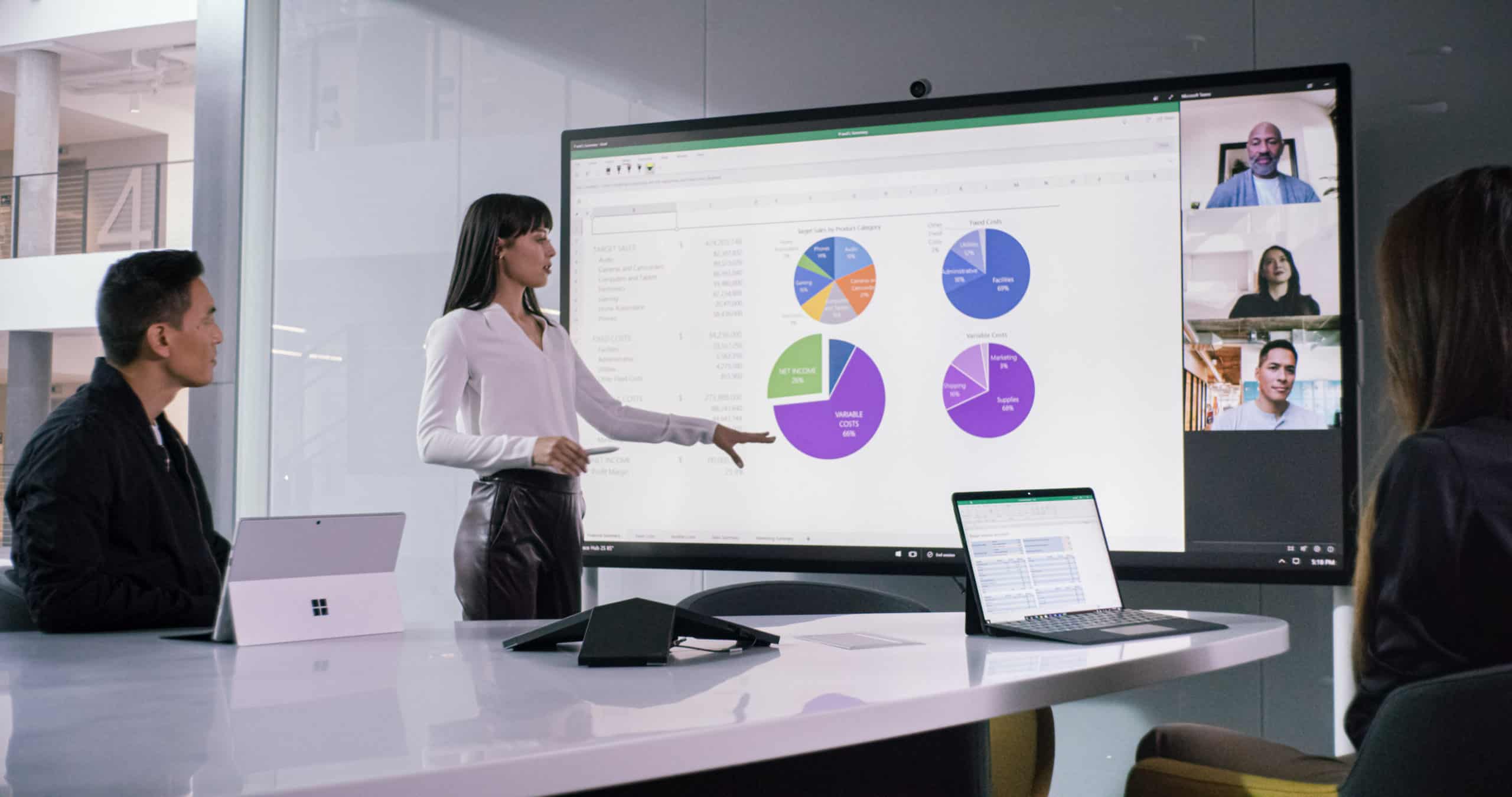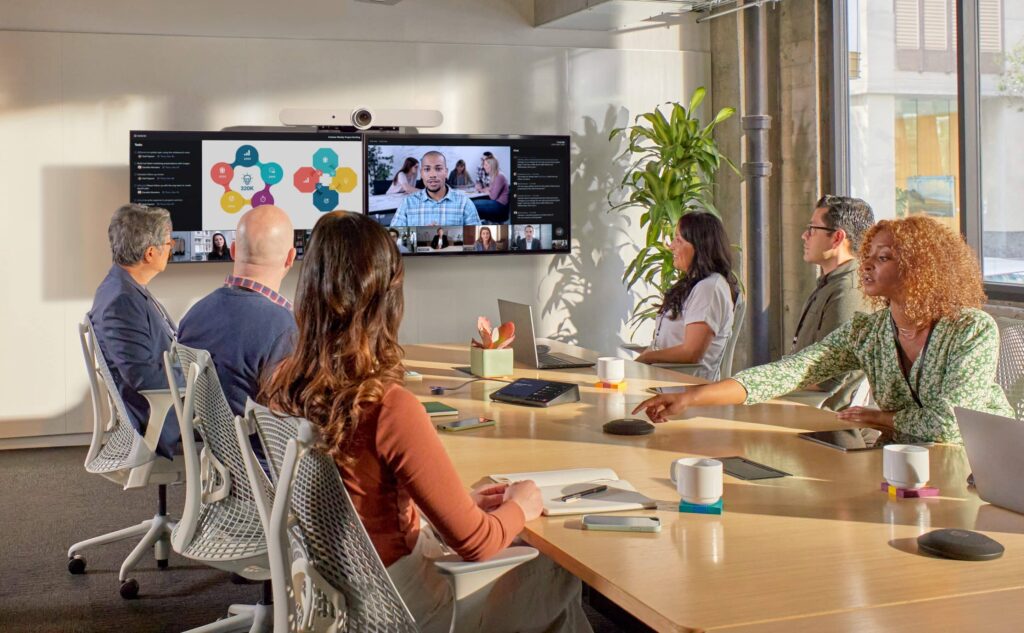
Aug 15, 2025
How to make Android-Based Meetings more secure
View moreJun 29 - 2023

Many teams can work anywhere, still get things done, and meet their business goals. But are we losing anything by embracing “anywhere work?” Let’s look at who has the better hybrid work experience.
When we move between the office and remote locations, there can be differences in how well our teams connect and collaborate. Technology can help bring everyone together. The challenge is to choose tools that deliver meeting equity and ensure a positive employee experience.
Working in the office means teams did the commute and spent less time with family. On the plus side, on-site employees can access amenities like meeting rooms and social gathering areas like kitchens and lounges. They can also use meeting technology that is (hopefully) routinely serviced and updated. There’s a stronger chance of making more human connections that support company culture, too.
Working remotely has its pros and cons as well. We save on gas, have more time at home and easily flex individual working hours. But when we don’t show up in person, we miss social interactions like chats at the water cooler and spontaneous collaboration. And there could be a fear of missing out on visibility with senior management and being considered for high-level projects and promotions.
So, when it comes to employee engagement, which group should we worry about, in-office teams or those working remotely?
Turns out it’s both.
A Forrest Consulting study commissioned by AVI-SPL indicated that hybrid workplace leaders are concerned about all employees, no matter where they work.
Discover ways Microsoft Surface Hub 2S and Teams help you enhance the hybrid meeting experience from on-site and remote teams.
Download the eBook “Avoid the Bowling Alley Effect Plus Seven More Ways to Enhance the human hybrid work experience.”
Request the eBook

How do you make everyone feel welcome in meetings and collaboration sessions? The solution is to emphasize both remote and on-site team needs when choosing hybrid work technology.
A better hybrid meeting experience delivers meeting equity for all. Team members should be on equal footing and see and hear each other clearly, whether they are on-site or joining online. Also, everyone should have access to the same collaboration tools to chat, share files, and annotate shared content.
| Surface Hub 2S supports human connections and collaboration with robust audio and video. Clear video captured by the 4k AI-enabled Surface Hub 2 Smart Camera helps teams see visual cues, enabling more social connections in online meetings. The camera’s automatic framing and 136-degree field of view ensure that everyone in the meeting room is seen. And it automatically corrects wide-angle lens distortion to keep faces looking natural and clear. Reframing when someone enters or leaves the room also creates a better meeting experience. Remote team members have an inclusive view of in-room interactions. And people in the room can move around and not worry about whether they will be captured on camera. |
Audio is essential for every meeting, too. No one will wonder if they are heard during the meeting, and everyone can connect and collaborate. Surface Hub’s integrated far-field mics and crystal-clear speakers ensure that every idea is heard.
Microsoft Surface Hub 2S using Teams enables flexibility and helps employees collaborate and co-create with on-screen content sharing and Microsoft Whiteboard software. Users can digitally ink on the Surface Hub 2S or from their PC while working offsite.
For users to experience meeting equity, it also helps when on-site and remote team members are at eye level during online meetings. Signature Microsoft Teams Rooms with Front Row setup avoids the “bowling alley” effect you can see in traditional conference rooms with long tables.
People in the room view remote participants at eye level too, and remote attendees feel part of the same space. This view also makes content, gestures, reactions, and chat easier for all to see and respond to, increasing engagement and productivity.
Microsoft announced plans to add the collaboration power of Surface Hub 2S to Signature Microsoft Teams Rooms by making it a Teams Rooms device later this year. That will enable Hub to utilize the Front Row view to allow everyone to meet face-to-face in a video meeting.
Discover more ways Microsoft Surface Hub 2S can enhance the hybrid work experience in our eBook. Download “Surface Hub 2S in the Hybrid Workplace” now.
| So, you’ve built or upgraded your rooms and helped employees outfit their home offices with hybrid work technology. Now, how do you know you delivered the best user experience for everyone? You can track meeting room utilization and device health with software and survey your users. AVI-SPL can help you take user experience tracking even further. Our software and services portfolio will help you ensure meeting room reliability and a high-quality Microsoft Teams user experience. These solutions make teamwork easier and reduce strain on IT resources. Explore user experience services |
We’re ready to help you deliver a better hybrid work experience and choose technology that supports on-site and remote teams. Contact AVI-SPL to get started today.